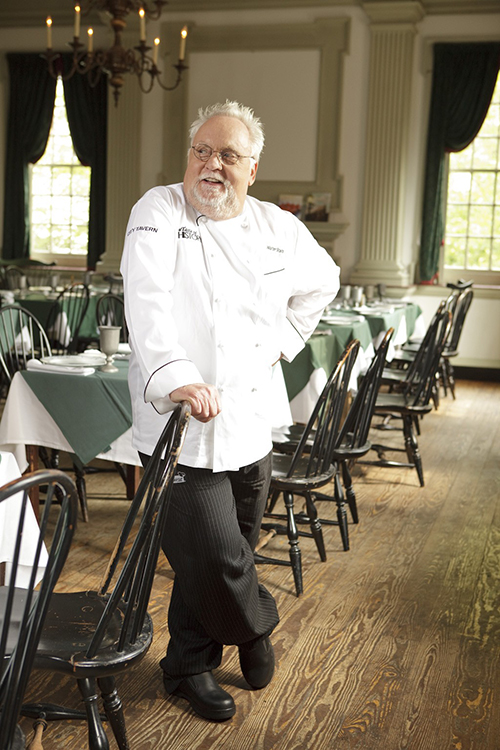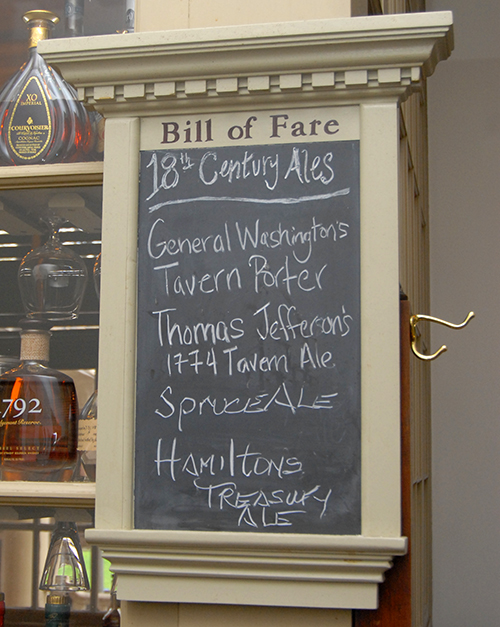Chef Walter Staib stands over a table of diners at his restaurant, City Tavern, a recreation of an 18th-century tavern in Philadelphia’s “Olde City.” The hostess, who wears a large skirt complete with an apron and bonnet, stands at the front of the restaurant greeting guests with a small curtsy. The lights are dim, much like they would have been in the 18th century. On each table sits special china trimmed with a blue-floral pattern, created to replicate the restaurant’s original dishes from the 1770s. Framed menus from the time period hang on the walls, detailing at least 10 unique dishes for each course. Food from the era also informs Staib’s talk with guests. He rattles off stories about Thomas Jefferson’s favorite dessert, crème brûlée, and shares the history of one of his restaurant’s bestsellers, a pepper pot stew that George Washington ate after he crossed the Delaware. As he speaks, his white beard provides a stark contrast to Staib’s black chef’s coat, and his German accent booms as he raises his hands, pointing toward a corner where George Washington may have dined.

“I really honestly feel that food is history, history is food,” Staib, 71, says. This philosophy has shaped his career, earning him critical acclaim. He has created concepts for about 650 restaurants. Since taking over as the restaurant’s operator in 1994, Staib has won several awards for his food, including the Colonial Society of Pennsylvania’s Contemporary Pioneer Award and Top Philadelphia Chef in the Condé Nast Cadillac Culinary Challenge in 2011. He has been a contestant on Food Network’s Iron Chef and has been nominated for a James Beard Award — the equivalent of an Oscar in the culinary world. In a 2014 review in the Philadelphia Inquirer, Stu Bykofsky says, “It is something special because no restaurant can match this ambience, this sense of place.”
In the entryway to City Tavern, photos of Staib around the world cover the wall. A photo of Staib sporting his signature round glasses, but looking slimmer and less gray, alongside a young Hillary Clinton stands out. Staib received congressional approval in 1994 to be the operator of City Tavern, a requirement for the historic landmark, which has stood in the same place since 1773. This means that Staib must adhere to government standards to maintain the restaurant’s authenticity (it also means City Tavern was closed during the government shutdown in 2013). Visitors can touch the same banister George Washington held and sit at the same tables as Paul Revere.
Jonathan Jones, Staib’s assistant, walks briskly through the restaurant. The seafood, which is supposed to arrive twice a day, is late, and Chef, as his employees call him, is not happy. Jones works with Staib at the restaurant, and on his show A Taste of History (now on its eighth season), which explores America’s culinary beginnings. As he travels through the halls of City Tavern, he mirrors Staib’s attention to historical details, rattling off facts about the different rooms. There’s the long room, named for its ability to seat large crowds and where members of the Continental Congress gathered to share a meal (and discuss the day’s events over a champagne shrub). A wall now separates the two rooms to the left of the entrance. They once shared only a partition, which was removed when 18th-century merchants turned the tavern into a market, where they sold everything but livestock.
But for Jones, the most impressive part of the tavern’s history remains its chef. “Isn’t it crazy how it takes an immigrant to preserve our history?” he says.
Born in Germany, Staib only planned to stay in the United States for one year as a visiting chef. But when he met his wife Gloria, Staib moved to the states permanently, although his consulting business, Concepts by Staib, Ltd., has taken him on a culinary tour across the globe. “Before I got involved here, I was traveling all over the world. You name it, I’ve been there,” Staib says. “So I’ve always had a more anthropological look towards food.”
The Emmy-award winning television host has become an expert on 18th-century Philadelphia, but operating a restaurant that looks and tastes like the 1770s was never a part of his plan. “I was here once as a customer in ‘79 and hated it. I [didn’t] want to have anything to do with it.” But when the building went up for sale, a friend convinced Staib to take a look. He begrudgingly agreed and ultimately decided to go for it. But it wasn’t the history of the three-story restaurant that sold him. “The upstairs little kitchen intrigued me, thinking that even if the restaurant is busy, I have my own little space so I can do my other stuff, which I really did for many years,” Staib says.
Executing his vision, however, proved challenging. The landmark received extensive damages from two fires in the 1800s. Beyond that, the Independence National Historical Park selected City Tavern as one of 40 important sites to be preserved due to the people and events connected to the space. That designation meant an exacting degree of scrutiny and authenticity regarding its restoration. Staff from the Department of the Interior researched old photos, personal accounts, and other documents to ensure the restaurant’s authenticity. From the food Staib serves to the clothing his employees wear, the restaurant must meet strict government standards to maintain its historic designation.

The flipside to those high standards is that following them earns Staib, as the operator of City Tavern, access to countless records from the time. In his home just 30 minutes outside the city, Staib has pored over enough old letters, recipes, and photographs to fill a museum. That research informs not only the physical appearance of the restaurant and those who work there but also what appears on diners’ plates. He works with original recipes from Hannah Glasse’s 1745 cookbook The Art of Cookery Made Plain and Easy, which he calls the culinary bible of the time, to recreate the simple and decadent dishes. In fact, each of the dishes served at City Tavern come from Glasse or from the Founding Fathers themselves (whose chefs probably used Glasse’s book as well, Staib explains). The recipes are simple. As an example, the Jefferson-inspired mushroom toast (a crowd favorite) has three parts: a slice of pan-toasted Sally Lunn bread, sautéed mushrooms, and a béarnaise sauce. That simplicity is amplified by Staib’s commitment to using high-quality ingredients. However, that commitment to pricey ingredients and generous portions means it’s difficult for the restaurant to turn a profit. Which is why without his other business ventures, Staib says, he would have been another failed restaurant owner.
Staib thinks about his late wife, Gloria. “[She] used to say, ‘You can’t take nothing with you when you leave this earth, so why do you work yourself silly seven days a week doing all this stuff?’” He clenches his hands together briefly — as if he’s holding hers — while he speaks. “And I said to her well, someday you’ll understand,” Staib says. “It’s more than a passion.”
For Staib, spending seven days a week greeting customers and fans and making sure the food meets his own high standards is worth it. Staib looks up at the bartender, Phil, to his side, dressed in a waistcoat and breeches. He grins. “It’s almost like mandated to me.”
As Staib motions to Phil for a drink, Jonathan brings a couple, Joe and Joanne, over after they finish their meal. They are fans of A Taste of History and came from North Carolina to meet the chef and have their cookbooks signed.
“I never leave home without my sharpie,” he says to the couple, who laugh as they hand him copies of two of his books.
“When is the new season going to be up?” Joe asks.
“It’s up, it’s in the satellites,” Staib says. “[PBS] just has to beam it down.”
Staib hands the books back to Joe and Joanne, who smile and wave as the chef wishes them a safe trip home. He looks at his phone, the most modern thing in the place. It’s almost 2:00 p.m. and the seafood still hasn’t arrived. He takes a sip of his drink.
Cover photo courtesy of City Tavern.